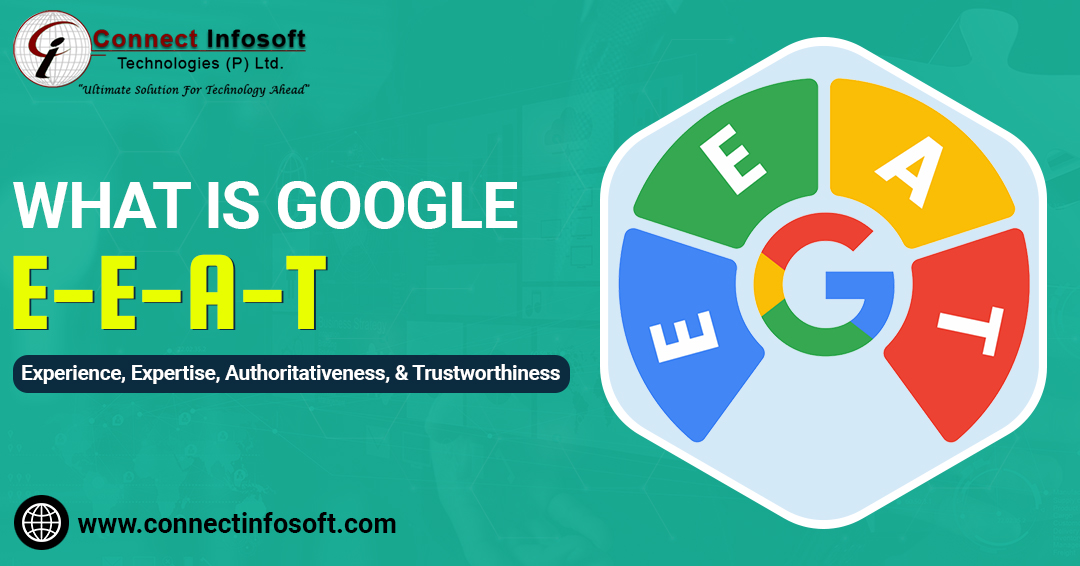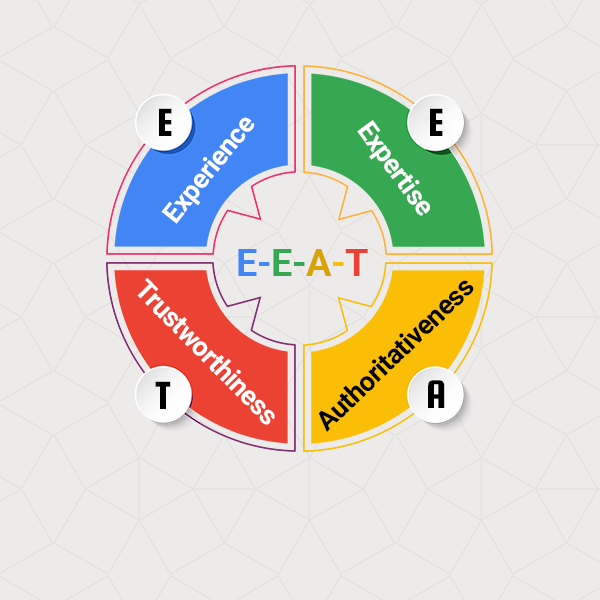What is Google E-E-A-T? SEO Update | Connect Infosoft

The letters E-E-A-T stand for Experience, Expertise, authoritativeness, and Trustworthiness. It is a methodology that Google uses to evaluate the quality of content on websites. E-E-A-T is an important component of Google's search algorithm since it determines which websites should appear higher in search results based on the credibility and worth of their content.
The term "user experience" refers to a variety of factors, including but not limited to:
User experience (UX) is a holistic term that encompasses a broad range of aspects, influencing how users interact with and perceive a product, service, or system. The following is a non-exhaustive list of key components that contribute to the overall user experience:
1. User Interface (UI) Design:
- Visual Design: The aesthetics, color schemes, typography, and overall visual appeal of the interface.
- Layout and Navigation: The arrangement of elements and how users navigate through the interface.
2. Usability:
- Accessibility: Assuring that the product is usable by persons of all abilities and disabilities.
- Learnability: How easily users can understand and navigate the system, especially for first-time users.
- Efficiency: The speed and ease with which users can accomplish tasks within the system.
3. Information Architecture:
- Content Organization: Structuring and organizing information in a way that is intuitive and easy for users to find.
- Hierarchy: Establishing a clear hierarchy of information to guide users through the content.
4. Interactivity:
- Responsiveness: The system's ability to respond promptly to user input, providing real-time feedback.
- Engagement: Design elements that encourage user interaction and participation.
5. Performance:
- Loading Times: How quickly the system or website responds and loads content.
- Reliability: The consistency of performance and the system's ability to handle varying loads.
6. Content Strategy:
- Relevance: Providing content that is relevant to users' needs and expectations.
- Clarity: Clearly conveying information and avoiding jargon that may confuse users.
7. Feedback and Error Handling:
- Error Messages: Providing clear and understandable error messages to guide users in resolving issues.
- Feedback: Informing users about the status of their actions and system responses.
8. User Engagement:
- Personalization: Tailoring the experience to individual user preferences and behaviors.
- Gamification: Incorporating game-like elements to enhance user engagement.
9. Mobile Responsiveness:
- Adaptability: Ensuring a seamless and optimized experience across various devices, especially on mobile.
10. User Research:
- User Testing: Collecting feedback from actual users to identify pain points and areas for improvement.
- Surveys and Analytics: Utilizing data and analytics tools to understand user behavior and preferences.
11. Consistency and Branding:
- Consistent Design: Maintaining a cohesive and consistent design throughout the user journey.
- Brand Alignment: Ensuring that the UX aligns with the overall brand image and messaging.
Google EEAT Abbreviation:
"Experience"
Google considers user experience to be an important consideration for ranking websites in search results. Optimising your website for user experience will help you rank higher and create a better experience for your users. Google announced the Page Experience Update in May 2021, emphasising user experience even more by integrating Core Web Vitals data in its ranking algorithm. Core Web Vitals assesses variables such as a website's loading speed, interaction, and visual stability.
"Expertise"
refers to the content creator's level of knowledge or competence in a given subject area. Someone with significant experience in the area under discussion should generate high-quality articles.
"Authoritativeness"
Relates to the trustworthiness of the information and the website that hosts it. The quality of the material, the site's reputation, external links and citations, and the credentials of the content producer can all be used to create authority.
"Trustworthiness"
Refers to the overall trustworthiness of the content and website. Trustworthiness is assessed by elements such as the truth of the information, transparency about the development and sources of the content, the site's security, and the user experience it provides.
E-E-A-T is an SEO acronym that stands for Experience, Expertise, authoritativeness and Trustworthiness. Google added the second E, Experience, in May 2021. Google confirmed in 2022 that E-E-A-T is graded for every search query. The notion of E-E-A-T is thoroughly explained in Google's Quality Raters' Guidelines.
We first encountered this abbreviation when Google's Search Quality Guidelines were disclosed in 2014. But, with Google's official 2020 announcement, we now know just how important E-E-A-T is. So E-E-A-T is expected to be a big concern this year—our SEO Services deal with getting your site to conform with Google's E-A-T most important parameters.
According to Google, E-E-A-T is one of the top three considerations for Page Quality. So, if you haven't been paying attention to E-E-A-T content, you should start right now.
Conclusion:
Google's E-E-A-T is a multifaceted approach aimed at ensuring that users are presented with reliable, accurate, and high-quality information. By focusing on Experience, expertise, authoritativeness, and trustworthiness, you can enhance your online presence, improve search engine rankings, and build lasting credibility with your audience. Stay committed to these principles, adapt to industry changes, and watch as your brand becomes a trusted authority in your niche.
